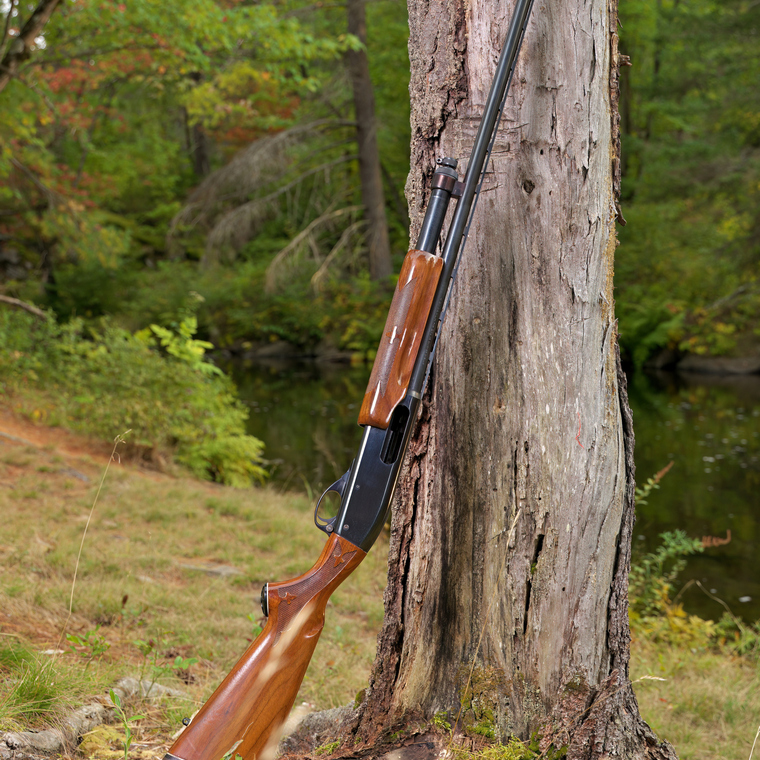Made: Approximately 12 million produced from 1950 to 2019, 2022-present
Models: More than 150 variations in 12, 16, 20, 28-gauges, and .410 cal.; 2¾″-3½″ chambers; 18-30″ barrels; various stocks, finishes and grades; models like Wingmaster, Brushmaster, Express, Fieldmaster, in field, skeet, trap, left-handed, youth, police, military, special editions, and commemorative versions.
Original price: 1950: 12-gauge, Wingmaster AP Standard, $69.95 US or ADL Deluxe, $79.95
Current value: Used: 12-gauge, Wingmaster $300-$800; 20-gauge, $500; New Fieldmaster 12-gauge, $699

I grew up around Cooey Model 84s, Model 12 Winchesters, and Browning Auto-5s. When I moved to Peterborough, friends introduced me to the Model 870. I now appreciate why Remington’s flagship firearm is one of the most popular shotguns of all time.
In 1908, Remington Arms needed a pump-action shotgun to challenge Winchester’s Model 1897/97. So, John Pedersen designed a hammerless bottom-loading-and-ejecting Model 10. Remington produced this 12-gauge until 1929, when they updated it with the Model 29. From 1921 to 1941, they also made a 20-gauge version, Model 17, under another Browning patent. These models, however, could not match Winchester’s Model 12.
Crawford C. Loomis provided Remington’s next chance. He transformed the bottom-ejecting Model 17 into the side-ejecting Model 31. From 1931 to 1949, Remington produced nearly 200,000 of them in 12, 16, and 20-gauge. While loved for the “ballbearing” smooth action, its 536 machined parts were expensive.
Remington learned to cut costs making Second World War guns, replacing much of their mill work with cheaper stamped parts. They introduced a new family of sleek firearms with the Model 11-48 semi-auto shotgun in 1948. Its design and many of its stamped parts were later interchangeable with the Model 870 shotgun and the Model 760/7600 pump-action rifles.
Remington made the 870 on the 11-48’s 16-gauge steel receiver. So, all 12, 16, and 20-gauges used the same stock. It added twist-resistant double action bars to provide a silkysmooth pump action, standardized cross-bolt safety and trigger assembly, and offered interchangeable barrels.
In January 1950, Remington launched 15 different Model 870 Wingmasters in 12, 16, and 20-gauge, priced from $69.95 to $615. Remington’s resounding success later forced Winchester to drop its Model 97. To compete, Winchester retired the Model 12 and revamped all model lines and production methods in 1964.
Remington expanded their market by adding Magnums, slug guns, 28-gauge and .410s, left-handed and youth versions, and RemChoke. In 1987, however, Remington released its Express series with cheaper finishes and components at half the price to compete with its new nemesis, Mossberg’s Model 500.
The resilient Model 870 survived four different owners, two bankruptcies, and interrupted production since then. While RemArms’ new Model 870 Fieldmaster should revive the brand, there are still many great used Wingmasters out there!
My sleek, versatile, and dependable 1972 left-handed 20-gauge Wingmaster is my favourite pump-action shotgun.
Originally published in the June-July 2025 issue of Ontario OUT of DOORS






Contact Information
PO Box 2800 / 4601 Guthrie Dr.
Peterborough, Ontario Canada K9J 8L5
Phone: 705-748-OFAH (6324)
Fax: 705-748-9577
Join Our Newsletter
Watch
Shop
Follow